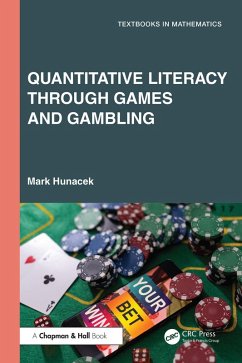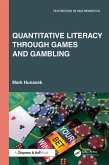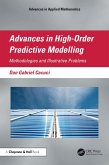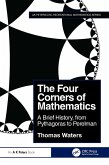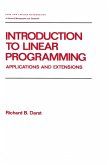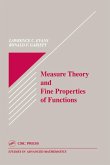Mark Hunacek
Quantitative Literacy Through Games and Gambling (eBook, PDF)
47,95 €
47,95 €
inkl. MwSt.
Sofort per Download lieferbar

24 °P sammeln
47,95 €
Als Download kaufen

47,95 €
inkl. MwSt.
Sofort per Download lieferbar

24 °P sammeln
Jetzt verschenken
Alle Infos zum eBook verschenken
47,95 €
inkl. MwSt.
Sofort per Download lieferbar
Alle Infos zum eBook verschenken

24 °P sammeln
Mark Hunacek
Quantitative Literacy Through Games and Gambling (eBook, PDF)
- Format: PDF
- Merkliste
- Auf die Merkliste
- Bewerten Bewerten
- Teilen
- Produkt teilen
- Produkterinnerung
- Produkterinnerung

Bitte loggen Sie sich zunächst in Ihr Kundenkonto ein oder registrieren Sie sich bei
bücher.de, um das eBook-Abo tolino select nutzen zu können.
Hier können Sie sich einloggen
Hier können Sie sich einloggen
Sie sind bereits eingeloggt. Klicken Sie auf 2. tolino select Abo, um fortzufahren.

Bitte loggen Sie sich zunächst in Ihr Kundenkonto ein oder registrieren Sie sich bei bücher.de, um das eBook-Abo tolino select nutzen zu können.
This book was developed to address a need. Quantitative Literacy courses have been established in the mathematics curriculum for decades now. The students in these courses typically dislike and fear mathematics, and the result is often a class populated by many students that are unmotivated and uninterested in the material.
- Geräte: PC
- mit Kopierschutz
- eBook Hilfe
Andere Kunden interessierten sich auch für
![Quantitative Literacy Through Games and Gambling (eBook, ePUB) Quantitative Literacy Through Games and Gambling (eBook, ePUB)]() Mark HunacekQuantitative Literacy Through Games and Gambling (eBook, ePUB)47,95 €
Mark HunacekQuantitative Literacy Through Games and Gambling (eBook, ePUB)47,95 €![Your Essential Guide to Quantitative Hedge Fund Investing (eBook, PDF) Your Essential Guide to Quantitative Hedge Fund Investing (eBook, PDF)]() Marat MolybogaYour Essential Guide to Quantitative Hedge Fund Investing (eBook, PDF)50,95 €
Marat MolybogaYour Essential Guide to Quantitative Hedge Fund Investing (eBook, PDF)50,95 €![Advances in High-Order Predictive Modeling (eBook, PDF) Advances in High-Order Predictive Modeling (eBook, PDF)]() Dan Gabriel CacuciAdvances in High-Order Predictive Modeling (eBook, PDF)51,95 €
Dan Gabriel CacuciAdvances in High-Order Predictive Modeling (eBook, PDF)51,95 €![The Four Corners of Mathematics (eBook, PDF) The Four Corners of Mathematics (eBook, PDF)]() Thomas WatersThe Four Corners of Mathematics (eBook, PDF)47,95 €
Thomas WatersThe Four Corners of Mathematics (eBook, PDF)47,95 €![Introduction to Linear Programming (eBook, PDF) Introduction to Linear Programming (eBook, PDF)]() Introduction to Linear Programming (eBook, PDF)100,95 €
Introduction to Linear Programming (eBook, PDF)100,95 €![Sustainable Life Insurance (eBook, PDF) Sustainable Life Insurance (eBook, PDF)]() Aymeric KalifeSustainable Life Insurance (eBook, PDF)103,95 €
Aymeric KalifeSustainable Life Insurance (eBook, PDF)103,95 €![Measure Theory and Fine Properties of Functions (eBook, PDF) Measure Theory and Fine Properties of Functions (eBook, PDF)]() Lawrencecraig EvansMeasure Theory and Fine Properties of Functions (eBook, PDF)52,95 €
Lawrencecraig EvansMeasure Theory and Fine Properties of Functions (eBook, PDF)52,95 €-
-
-
This book was developed to address a need. Quantitative Literacy courses have been established in the mathematics curriculum for decades now. The students in these courses typically dislike and fear mathematics, and the result is often a class populated by many students that are unmotivated and uninterested in the material.
Dieser Download kann aus rechtlichen Gründen nur mit Rechnungsadresse in A, B, BG, CY, CZ, D, DK, EW, E, FIN, F, GR, HR, H, IRL, I, LT, L, LR, M, NL, PL, P, R, S, SLO, SK ausgeliefert werden.
Produktdetails
- Produktdetails
- Verlag: Taylor & Francis
- Seitenzahl: 120
- Erscheinungstermin: 4. Oktober 2024
- Englisch
- ISBN-13: 9781040131213
- Artikelnr.: 72285190
- Verlag: Taylor & Francis
- Seitenzahl: 120
- Erscheinungstermin: 4. Oktober 2024
- Englisch
- ISBN-13: 9781040131213
- Artikelnr.: 72285190
- Herstellerkennzeichnung Die Herstellerinformationen sind derzeit nicht verfügbar.
Mark Hunacek received his Ph.D. in mathematics from Rutgers University, and also acquired a wife who that year had also gotten a mathematics Ph.D. Faced with the familiar "two body problem", which was more of an issue in 1978 than it is now, he went to law school and then spent almost three decades practicing law. After retiring from the practice of law, things came full circle and he was lucky enough to be offered a position in the mathematics department at Iowa State University, where, as one of his responsibilities, he redesigned and oversaw the two quantitative literacy courses offered there, one of which inspired this textbook. In 2021 he retired and became a Teaching Professor Emeritus.
1. Basic Discrete Probability
1.1. Elementary Set Theory
1.2. Sample Spaces
1.3. Events
1.4. Definition of Probability
1.5. Complimentary Events
1.6. Expected Value
1.7. Odds
2. Roulette
2.1. The Rules of the Game
2.2. Some Basic Probability Calculations
2.3. Roulette "Systems"
3. Conditional Probability and Independence
3.1. Definition of Conditional Probability
3.2. Law of Total Probability
3.3. Independent Events
3.4. The Monty Hall Problem
4. Craps
4.1. Rules of the Game
4.2. Analysis of the Shooter's Game
4.3. Other Bets
5. Counting Large Sets: An Introduction to Combinatorics
5.1. Two Counting Rules
5.2. Permutations and Combinations
6. Poker
6.1. Poker Hands and their Probabilities
6.2. Video Poker
6.3. Texas Hold 'Em
7. Lotteries and Keno
7.1. Lotteries and Powerball
7.2. Keno
8. Blackjack
8.1. Rules of the Game
8.2. Basic Blackjack Calculations
8.3. Card Counting
9. Farkle
9.1. Rules of the Game
9.2. Various Farkle Probability Calculations
9.3. Should You Risk Another Roll? The Probability of Farkling
10. An Introduction to Game Theory
10.1. Introduction and Basic Definitions
10.2. Zero-sum Games: Domination
10.3. Zero-sum Games: Saddle Points
10.4. Zero-sum Games: No Saddle Points
10.5. Solving 2 x 2 Zero-sum Games
10.6. A Simplified Poker Game
1.1. Elementary Set Theory
1.2. Sample Spaces
1.3. Events
1.4. Definition of Probability
1.5. Complimentary Events
1.6. Expected Value
1.7. Odds
2. Roulette
2.1. The Rules of the Game
2.2. Some Basic Probability Calculations
2.3. Roulette "Systems"
3. Conditional Probability and Independence
3.1. Definition of Conditional Probability
3.2. Law of Total Probability
3.3. Independent Events
3.4. The Monty Hall Problem
4. Craps
4.1. Rules of the Game
4.2. Analysis of the Shooter's Game
4.3. Other Bets
5. Counting Large Sets: An Introduction to Combinatorics
5.1. Two Counting Rules
5.2. Permutations and Combinations
6. Poker
6.1. Poker Hands and their Probabilities
6.2. Video Poker
6.3. Texas Hold 'Em
7. Lotteries and Keno
7.1. Lotteries and Powerball
7.2. Keno
8. Blackjack
8.1. Rules of the Game
8.2. Basic Blackjack Calculations
8.3. Card Counting
9. Farkle
9.1. Rules of the Game
9.2. Various Farkle Probability Calculations
9.3. Should You Risk Another Roll? The Probability of Farkling
10. An Introduction to Game Theory
10.1. Introduction and Basic Definitions
10.2. Zero-sum Games: Domination
10.3. Zero-sum Games: Saddle Points
10.4. Zero-sum Games: No Saddle Points
10.5. Solving 2 x 2 Zero-sum Games
10.6. A Simplified Poker Game
1. Basic Discrete Probability
1.1. Elementary Set Theory
1.2. Sample Spaces
1.3. Events
1.4. Definition of Probability
1.5. Complimentary Events
1.6. Expected Value
1.7. Odds
2. Roulette
2.1. The Rules of the Game
2.2. Some Basic Probability Calculations
2.3. Roulette "Systems"
3. Conditional Probability and Independence
3.1. Definition of Conditional Probability
3.2. Law of Total Probability
3.3. Independent Events
3.4. The Monty Hall Problem
4. Craps
4.1. Rules of the Game
4.2. Analysis of the Shooter's Game
4.3. Other Bets
5. Counting Large Sets: An Introduction to Combinatorics
5.1. Two Counting Rules
5.2. Permutations and Combinations
6. Poker
6.1. Poker Hands and their Probabilities
6.2. Video Poker
6.3. Texas Hold 'Em
7. Lotteries and Keno
7.1. Lotteries and Powerball
7.2. Keno
8. Blackjack
8.1. Rules of the Game
8.2. Basic Blackjack Calculations
8.3. Card Counting
9. Farkle
9.1. Rules of the Game
9.2. Various Farkle Probability Calculations
9.3. Should You Risk Another Roll? The Probability of Farkling
10. An Introduction to Game Theory
10.1. Introduction and Basic Definitions
10.2. Zero-sum Games: Domination
10.3. Zero-sum Games: Saddle Points
10.4. Zero-sum Games: No Saddle Points
10.5. Solving 2 x 2 Zero-sum Games
10.6. A Simplified Poker Game
1.1. Elementary Set Theory
1.2. Sample Spaces
1.3. Events
1.4. Definition of Probability
1.5. Complimentary Events
1.6. Expected Value
1.7. Odds
2. Roulette
2.1. The Rules of the Game
2.2. Some Basic Probability Calculations
2.3. Roulette "Systems"
3. Conditional Probability and Independence
3.1. Definition of Conditional Probability
3.2. Law of Total Probability
3.3. Independent Events
3.4. The Monty Hall Problem
4. Craps
4.1. Rules of the Game
4.2. Analysis of the Shooter's Game
4.3. Other Bets
5. Counting Large Sets: An Introduction to Combinatorics
5.1. Two Counting Rules
5.2. Permutations and Combinations
6. Poker
6.1. Poker Hands and their Probabilities
6.2. Video Poker
6.3. Texas Hold 'Em
7. Lotteries and Keno
7.1. Lotteries and Powerball
7.2. Keno
8. Blackjack
8.1. Rules of the Game
8.2. Basic Blackjack Calculations
8.3. Card Counting
9. Farkle
9.1. Rules of the Game
9.2. Various Farkle Probability Calculations
9.3. Should You Risk Another Roll? The Probability of Farkling
10. An Introduction to Game Theory
10.1. Introduction and Basic Definitions
10.2. Zero-sum Games: Domination
10.3. Zero-sum Games: Saddle Points
10.4. Zero-sum Games: No Saddle Points
10.5. Solving 2 x 2 Zero-sum Games
10.6. A Simplified Poker Game
1. Basic Discrete Probability
1.1. Elementary Set Theory
1.2. Sample Spaces
1.3. Events
1.4. Definition of Probability
1.5. Complimentary Events
1.6. Expected Value
1.7. Odds
2. Roulette
2.1. The Rules of the Game
2.2. Some Basic Probability Calculations
2.3. Roulette "Systems"
3. Conditional Probability and Independence
3.1. Definition of Conditional Probability
3.2. Law of Total Probability
3.3. Independent Events
3.4. The Monty Hall Problem
4. Craps
4.1. Rules of the Game
4.2. Analysis of the Shooter's Game
4.3. Other Bets
5. Counting Large Sets: An Introduction to Combinatorics
5.1. Two Counting Rules
5.2. Permutations and Combinations
6. Poker
6.1. Poker Hands and their Probabilities
6.2. Video Poker
6.3. Texas Hold 'Em
7. Lotteries and Keno
7.1. Lotteries and Powerball
7.2. Keno
8. Blackjack
8.1. Rules of the Game
8.2. Basic Blackjack Calculations
8.3. Card Counting
9. Farkle
9.1. Rules of the Game
9.2. Various Farkle Probability Calculations
9.3. Should You Risk Another Roll? The Probability of Farkling
10. An Introduction to Game Theory
10.1. Introduction and Basic Definitions
10.2. Zero-sum Games: Domination
10.3. Zero-sum Games: Saddle Points
10.4. Zero-sum Games: No Saddle Points
10.5. Solving 2 x 2 Zero-sum Games
10.6. A Simplified Poker Game
1.1. Elementary Set Theory
1.2. Sample Spaces
1.3. Events
1.4. Definition of Probability
1.5. Complimentary Events
1.6. Expected Value
1.7. Odds
2. Roulette
2.1. The Rules of the Game
2.2. Some Basic Probability Calculations
2.3. Roulette "Systems"
3. Conditional Probability and Independence
3.1. Definition of Conditional Probability
3.2. Law of Total Probability
3.3. Independent Events
3.4. The Monty Hall Problem
4. Craps
4.1. Rules of the Game
4.2. Analysis of the Shooter's Game
4.3. Other Bets
5. Counting Large Sets: An Introduction to Combinatorics
5.1. Two Counting Rules
5.2. Permutations and Combinations
6. Poker
6.1. Poker Hands and their Probabilities
6.2. Video Poker
6.3. Texas Hold 'Em
7. Lotteries and Keno
7.1. Lotteries and Powerball
7.2. Keno
8. Blackjack
8.1. Rules of the Game
8.2. Basic Blackjack Calculations
8.3. Card Counting
9. Farkle
9.1. Rules of the Game
9.2. Various Farkle Probability Calculations
9.3. Should You Risk Another Roll? The Probability of Farkling
10. An Introduction to Game Theory
10.1. Introduction and Basic Definitions
10.2. Zero-sum Games: Domination
10.3. Zero-sum Games: Saddle Points
10.4. Zero-sum Games: No Saddle Points
10.5. Solving 2 x 2 Zero-sum Games
10.6. A Simplified Poker Game
1. Basic Discrete Probability
1.1. Elementary Set Theory
1.2. Sample Spaces
1.3. Events
1.4. Definition of Probability
1.5. Complimentary Events
1.6. Expected Value
1.7. Odds
2. Roulette
2.1. The Rules of the Game
2.2. Some Basic Probability Calculations
2.3. Roulette "Systems"
3. Conditional Probability and Independence
3.1. Definition of Conditional Probability
3.2. Law of Total Probability
3.3. Independent Events
3.4. The Monty Hall Problem
4. Craps
4.1. Rules of the Game
4.2. Analysis of the Shooter's Game
4.3. Other Bets
5. Counting Large Sets: An Introduction to Combinatorics
5.1. Two Counting Rules
5.2. Permutations and Combinations
6. Poker
6.1. Poker Hands and their Probabilities
6.2. Video Poker
6.3. Texas Hold 'Em
7. Lotteries and Keno
7.1. Lotteries and Powerball
7.2. Keno
8. Blackjack
8.1. Rules of the Game
8.2. Basic Blackjack Calculations
8.3. Card Counting
9. Farkle
9.1. Rules of the Game
9.2. Various Farkle Probability Calculations
9.3. Should You Risk Another Roll? The Probability of Farkling
10. An Introduction to Game Theory
10.1. Introduction and Basic Definitions
10.2. Zero-sum Games: Domination
10.3. Zero-sum Games: Saddle Points
10.4. Zero-sum Games: No Saddle Points
10.5. Solving 2 x 2 Zero-sum Games
10.6. A Simplified Poker Game
1.1. Elementary Set Theory
1.2. Sample Spaces
1.3. Events
1.4. Definition of Probability
1.5. Complimentary Events
1.6. Expected Value
1.7. Odds
2. Roulette
2.1. The Rules of the Game
2.2. Some Basic Probability Calculations
2.3. Roulette "Systems"
3. Conditional Probability and Independence
3.1. Definition of Conditional Probability
3.2. Law of Total Probability
3.3. Independent Events
3.4. The Monty Hall Problem
4. Craps
4.1. Rules of the Game
4.2. Analysis of the Shooter's Game
4.3. Other Bets
5. Counting Large Sets: An Introduction to Combinatorics
5.1. Two Counting Rules
5.2. Permutations and Combinations
6. Poker
6.1. Poker Hands and their Probabilities
6.2. Video Poker
6.3. Texas Hold 'Em
7. Lotteries and Keno
7.1. Lotteries and Powerball
7.2. Keno
8. Blackjack
8.1. Rules of the Game
8.2. Basic Blackjack Calculations
8.3. Card Counting
9. Farkle
9.1. Rules of the Game
9.2. Various Farkle Probability Calculations
9.3. Should You Risk Another Roll? The Probability of Farkling
10. An Introduction to Game Theory
10.1. Introduction and Basic Definitions
10.2. Zero-sum Games: Domination
10.3. Zero-sum Games: Saddle Points
10.4. Zero-sum Games: No Saddle Points
10.5. Solving 2 x 2 Zero-sum Games
10.6. A Simplified Poker Game
